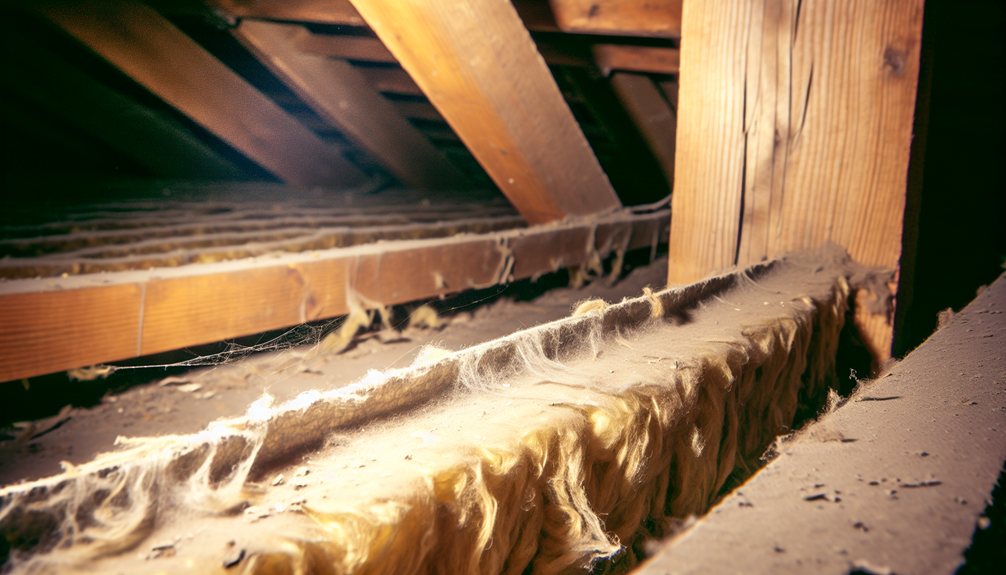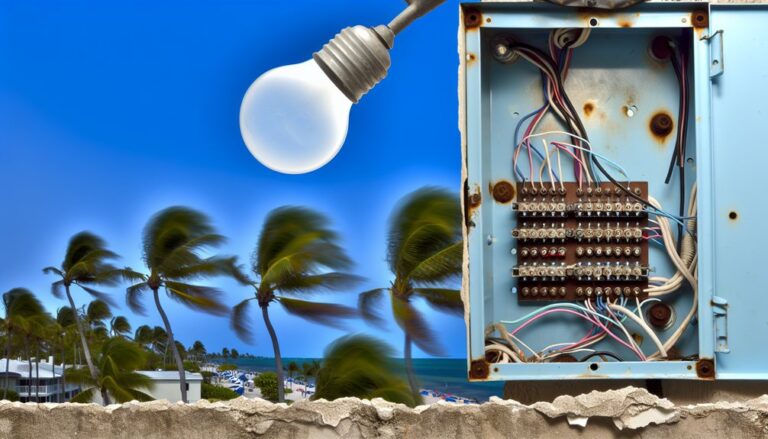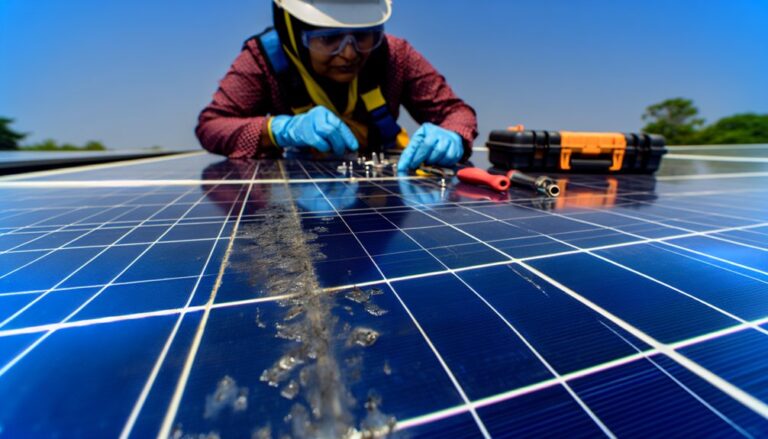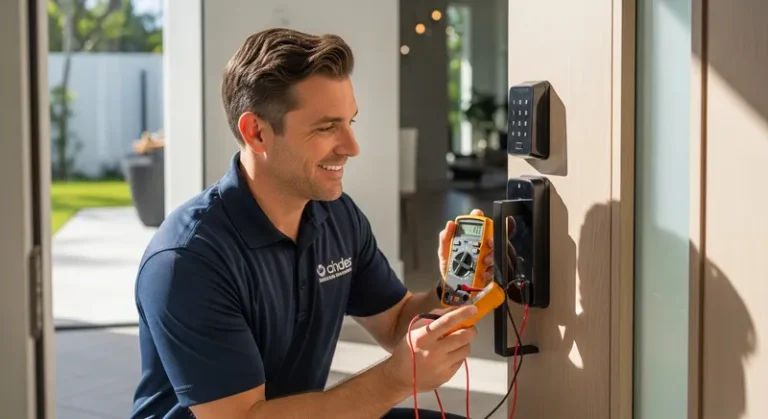Issues With Old Home Insulation
Old home insulation often leads to energy inefficiencies, increased utility costs, and health risks from outdated materials. As insulation ages, it can compress or settle, reducing its effectiveness and allowing drafts. Additionally, harmful particles may be released, and moisture retention can foster mold growth. If you notice fluctuating temperatures or rising bills, it’s likely time for an upgrade. Discovering the right solutions for these challenges can greatly enhance your home’s comfort and efficiency while ensuring a healthier environment.
Key Takeaways
- Aging insulation materials can lose effectiveness, leading to reduced R-value and compromised energy performance in older homes.
- Health risks, including respiratory issues and mold growth, can arise from degraded insulation materials.
- Signs of insulation problems include drafts, increased energy bills, and visible moisture or pest infestations.
- Common types of old insulation, like fiberglass and cellulose, settle over time, creating gaps that diminish thermal performance.
- Upgrading insulation not only enhances comfort but can also improve indoor air quality and lower energy expenses.
The Importance of Insulation in Older Homes
When you step into an older home, you might admire its charm, but you should also consider the insulation—or lack thereof—that can greatly impact your comfort and energy bills.
Many older homes feature outdated insulation materials that don’t meet modern efficiency standards. This can lead to drafts, temperature fluctuations, and higher heating and cooling costs.
Insulation upgrades can markedly improve your home’s energy performance, ensuring that your living spaces remain comfortable year-round. By investing in newer, more effective insulation solutions, you can create a more consistent indoor climate and reduce energy expenses.
Understanding the importance of insulation in older homes allows you to make informed decisions about necessary upgrades, enhancing both comfort and property value in the long run.
Common Types of Aging Insulation Materials
Older homes often contain insulation materials that have not aged well and may no longer provide adequate thermal resistance. Two common types of aging insulation are fiberglass batting and cellulose material.
| Insulation Type | Characteristics |
|---|---|
| Fiberglass Batting | Can compress over time, reducing R-value and effectiveness. |
| Cellulose Material | Prone to settling, leading to gaps and decreased insulation value. |
| Rock Wool | May absorb moisture, compromising its thermal performance. |
| Spray Foam | Can degrade with age, losing its seal and insulation capability. |
| Polystyrene Panels | May become brittle, leading to cracks and air leaks. |
Health Risks Associated With Old Insulation
While many homeowners may not realize it, old insulation can pose significant health risks that extend beyond mere energy inefficiency. As insulation materials degrade over time, they can release harmful particles and substances into your home’s air.
For instance, fiberglass insulation can produce tiny glass fibers that may cause respiratory issues when inhaled. Additionally, older insulation often contains asbestos, a known carcinogen. These health concerns can lead to serious long-term effects, especially for vulnerable populations like children and the elderly.
Moreover, material degradation can create an environment conducive to mold growth, exacerbating allergies and respiratory problems. It’s essential to assess your insulation regularly to safeguard your home and health from these hidden dangers.
Signs Your Insulation Needs Replacement
If you notice drafts in your home or experience fluctuating temperatures despite adjusting your thermostat, it’s time to evaluate your insulation.
Look for insulation deterioration signs, such as visible sagging, moisture accumulation, or pest infestations. These issues indicate your insulation’s effectiveness is compromised. You may also find increased energy bills, which can signal heat loss.
When considering replacement, account for replacement cost factors like the type of insulation, the area needing service, and labor expenses.
Older homes often have outdated materials, like fiberglass or cellulose, that may not perform well by today’s standards.
Identifying these signs early can save you money and improve your home’s comfort, making timely insulation replacement a wise investment.
Impact of Poor Insulation on Energy Efficiency
Outdated or damaged insulation directly affects your home’s energy efficiency. When insulation is compromised, you experience significant energy loss, leading to higher utility bills.
One major contributor to this problem is thermal bridging, where heat flows through areas of your home that lack proper insulation, such as walls and ceilings. This phenomenon creates cold spots, forcing your heating system to work harder to maintain a comfortable temperature.
As a result, energy efficiency plummets, and you may face increased wear and tear on your HVAC system. Addressing insulation issues isn’t just about comfort; it’s an essential step toward reducing energy consumption and enhancing your overall home performance.
Investing in proper insulation can mitigate these effects and lead to long-term savings.
Understanding Asbestos and Its Dangers
As you explore your home’s insulation, it’s important to understand the potential dangers of asbestos, a material once widely used for its insulating properties.
Asbestos exposure can lead to serious health issues, including lung cancer and mesothelioma. If your home was built before the 1980s, it’s vital to assess the insulation for asbestos content.
Consider these key points:
- Identify: Check for materials like vermiculite or older insulation types that may contain asbestos.
- Assess: If you suspect asbestos, avoid disturbing it, as this can release harmful fibers.
- Handle Safely: Always consult professionals for safe handling and removal if asbestos is confirmed.
Understanding these aspects will help you make informed decisions about your home’s insulation and health safety.
The Role of Insulation in Indoor Air Quality
Insulation does more than just keep your home warm; it plays a significant role in maintaining indoor air quality. Proper insulation helps reduce the entry of indoor pollutants, such as dust, mold, and allergens, which can accumulate and compromise your health. It also assists in regulating air circulation, ensuring that fresh air circulates while minimizing stagnation.
| Indoor Pollutants | Effects on Health | Insulation’s Role |
|---|---|---|
| Dust | Respiratory issues | Reduces dust entry |
| Mold | Allergies | Controls moisture |
| VOCs | Headaches | Limits exposure |
| Pollen | Asthma | Blocks outside air |
| Smoke | Lung diseases | Enhances filtration |
Upgrading Insulation: Options and Benefits
Upgrading your home’s insulation can greatly enhance energy efficiency and comfort, especially if you’re dealing with older materials that may have deteriorated over time.
Today, you have a variety of insulation materials and modern techniques to choose from that can considerably improve your home’s performance.
- Fiberglass Batts: Affordable and effective, ideal for attics and walls.
- Spray Foam: Offers superior air sealing and can fill irregular spaces.
- Cellulose: Made from recycled materials, it’s an eco-friendly option.
These upgrades not only reduce your energy bills but also bolster indoor air quality and comfort.
Steps to Safely Remove and Replace Old Insulation
When tackling the upgrade of your home’s insulation, safely removing the old material is an essential step that can’t be overlooked. Begin by wearing proper safety gear, including gloves, masks, and goggles to protect against harmful insulation materials. Follow established safety protocols to minimize health risks.
Here’s a simple guide to help you:
| Step | Action | Notes |
|---|---|---|
| 1. Prepare | Clear the area | Guarantee good ventilation |
| 2. Remove | Carefully extract old insulation | Avoid damaging structures |
| 3. Dispose | Follow local regulations | Use appropriate disposal methods |
| 4. Replace | Install new insulation materials | Consider eco-friendly options |
About Us
We understand that electrical issues can be stressful and overwhelming. That’s why we are here to lend a helping hand and provide you with the best electrical services in town. As a team of experienced electricians, we take pride in our ability to solve any electrical problem with precision and care.
Pages
Follow us
© 2025 By Electrician Fort Lauderdale Today







